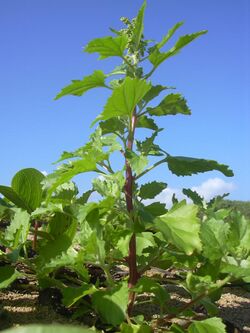Biology:Chenopodiastrum murale
| Chenopodiastrum murale | |
|---|---|

| |
| Scientific classification | |
| Kingdom: | Plantae |
| Clade: | Tracheophytes |
| Clade: | Angiosperms |
| Clade: | Eudicots |
| Order: | Caryophyllales |
| Family: | Amaranthaceae |
| Genus: | Chenopodiastrum |
| Species: | C. murale
|
| Binomial name | |
| Chenopodiastrum murale (L.) S. Fuentes, Uotila & Borsch
| |
| Synonyms[1] | |
| |
Chenopodiastrum murale,[2] (Syn. Chenopodium murale) is a species of plant in the family Amaranthaceae known by the common names nettle-leaved goosefoot,[3] Australian-spinach, salt-green, and sowbane.[1] This plant is native to Europe and parts of Asia and northern Africa, but it is widespread worldwide, particularly in tropical and subtropical areas due to the ease of it being introduced.[1] It is a common weed of fields and roadsides.
Description
This is an annual herb reaching 70 centimeters in height with an erect stem which is usually red or red-streaked green and leafy with green foliage. The oval to triangular leaves are toothed and broad, smooth on the upper surface and powdery on the undersides.
The inflorescences are powdery clusters of spherical buds. The buds do not open into typical flower blossoms but remain with the sepals covering the ovary as the fruit develops.
Uses
The seeds are edible, and the shoots, stalks, and leaves can be eaten as greens.[4] The 1889 book 'The Useful Native Plants of Australia records that common names include "Australian Spinach" and "Fat-hen". It also states that it is a "pot-herb", which may be utilised in the same manner as spinach.[5]
Care should be taken not to confuse this species with deadly black nightshade, which looks similar when young. The leaves of Chenopodium murale have a white mealy texture, and the axils have a red streak.[6]
References
- ↑ 1.0 1.1 1.2 {{citation | mode = cs1 | title = Chenopodiastrum murale | work = Germplasm Resources Information Network (GRIN) | url = https://npgsweb.ars-grin.gov/gringlobal/taxonomydetail.aspx?466031 | publisher = [[Organization:Agricultural Research ServAgricultural Research Service (ARS), United States Department of Agriculture (USDA) | access-date = 9 July 2013 }}
- ↑ Susy Fuentes-Bazan, Pertti Uotila, Thomas Borsch: A novel phylogeny-based generic classification for Chenopodium sensu lato, and a tribal rearrangement of Chenopodioideae (Chenopodiaceae). In: Willdenowia. Vol. 42, No. 1, 2012, p. 14.
- ↑ (xls) BSBI List 2007, Botanical Society of Britain and Ireland, https://bsbi.org/download/3542/, retrieved 2014-10-17
- ↑ "Native American Ethnobotany" (Database). University of Michigan - Dearborn. http://herb.umd.umich.edu/herb/search.pl?searchstring=Chenopodium+murale.
- ↑ J. H. Maiden (1889). The useful native plants of Australia : Including Tasmania. Turner and Henderson, Sydney. https://primo-slnsw.hosted.exlibrisgroup.com/primo-explore/fulldisplay?docid=SLNSW_ALMA21105097830002626&context=L&vid=SLNSW&search_scope=EEA&tab=default_tab&lang=en_US.
- ↑ Nyerges, Christopher (2017). Foraging Washington: Finding, Identifying, and Preparing Edible Wild Foods. Guilford, CT: Falcon Guides. ISBN 978-1-4930-2534-3. OCLC 965922681.
- Everitt, J.H.; Lonard, R.L.; Little, C.R. (2007). Weeds in South Texas and Northern Mexico. Lubbock: Texas Tech University Press. ISBN:0-89672-614-2
External links
- "Chenopodiastrum murale". National Center for Biotechnology Information (NCBI). https://www.ncbi.nlm.nih.gov/Taxonomy/Browser/wwwtax.cgi?id=46091.
- Chenopodiastrum murale at Tropicos
- Jepson Manual Treatment
- USDA Plants Profile
- Flora of North America Treatment
- Photo gallery
Wikidata ☰ {{{from}}} entry

